
Lockport Mineral Spring Mystery
Posted February 6, 2013 at 7:00 pm
By Dr. James M. Boles and Melissa Royer, ContributorsBecause Niagara County has the notable Niagara Escarpment running along its width—east to west—there were, and still are, many natural springs as the ground water eventually flows north to Lake Ontario.
Research and reading about mineral springs in the eastern United States shows a pattern of discovery by early travelers and settlers and their reports often mention the local Native Americans using the springs for medicinal purposes. A spring was a clear water spring or mineral spring. The mineral spring generally had a smell and taste that was different from clear water. This was an early indication that the spring was a mineral spring. Once the spring was known as a mineral spring, local residents began using the waters to cure their medical problems as medicine of the times had little to offer. Soon businessmen would have the spring analyzed and would commercialize the spring and begin bottling and selling the water and/or building a sanitarium. The facility would then attract tourists and soon after, the very ill and invalids, all searching for a cure from this new mineral spring with its claims for healing.
Reviewing early accounts about the Niagara Region shows a similar pattern, there are many references to springs. Many of the Native American trails, which later became our roads, led to springs or had springs along the way. The springs were important as a geographic reference and drinking water for travelers and their animals. Soon after settlement, the springs became important for commercial purposes and medicinal use. It is felt that early construction projects such as the Erie Canal, bridges, railroads, sewer projects and water tunnels have disrupted some of the springs although many still remain.
Listed in the 1866 United States Geological Survey of the Mineral Springs of the United States was a well-known medicinal spring located in the Gulf, north of Lockport. It was analyzed as a saltine spring with traces of iron. An analysis of the “Lockport Mineral Water” was conducted by chemist George Hadley of Castleton, VT in 1861. From his analysis came this conclusion, “I have a strong conviction that it will prove a mineral water of great value and that it will establish for itself sooner or later a high reputation.” Mineral water from this spring which claimed to cure many ills was bottled and sold and an attempt was made to attract investors to build a sanitarium at the site. The area around the spring was known as “Wood Glen” and was advertised in the Lockport Daily Journal and Courier in 1861:
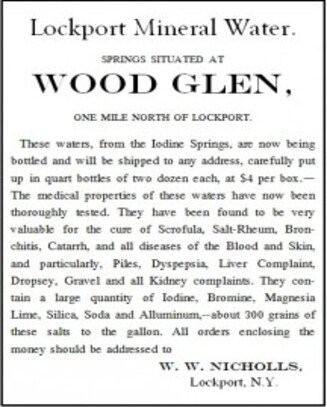
The Lockport Mineral Spring ran the following notice in May of 1862:
“…The mineral spring of our townsman Mr. St. John, located about a mile and a half west of the village is deserving of public favor. It is most romantically located, and the water for mineral and medical properties will compare favorably with that of the most noted watering places in the world.”
The businessmen involved in the Lockport Mineral Spring in the 1860s include William W. Nicholls (1817-1878), brother of the well-known Lockport lawyer Luman H. Nicholls (1815-1864), and perhaps John R. St. John (1805-1868). It is believed that Luman Nicholls purchased property in the Gulf prior to the Civil War, which in later years was owned by Oliver Tinney. Mr. Tinney was known to live near the Mineral Spring. An 1875 map of the Town of Lockport indicates O. Tinney owning property on West Jackson Street nearby his neighbor, Mrs. S. St. John. We have yet to discover the names of those involved in the Lockport Mineral Spring venture of the early 1900s.
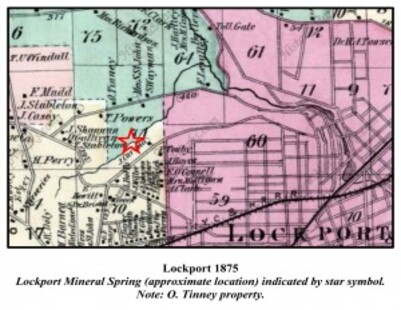
In 1964, a group connected to the Lockport Parks visited the Gulf area to determine if a Gulf Park should be established. In the group was Thomas Mulvey and Samuel Sposito, Park Board members; Lawrence R. Martin, Acting Superintendent of Parks, and Raymond C. Betsch, President of the Common Council. The reporter described finding “an old spring…in the mouth of a small cave-like opening,” on the banks of Indian Creek. Further down the creek, they found the remains of an old well house for the spring and a stone bottling basin with a 1911 date on it. (Public Support for Gulf Park Awaited by Park Commissioners, Lockport NY Union Sun and Journal: August 22, 1964)
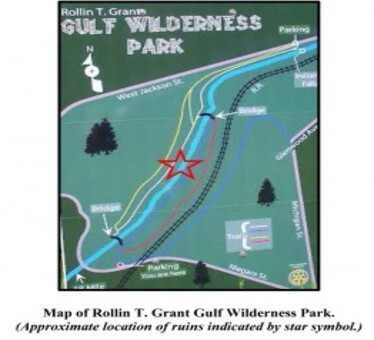
There are many old accounts that mention springs throughout the full Gulf area from the Little Indian Falls and west to the old city dump and the larger Indian Falls. This particular mineral spring is located in the Roland T. Grant Gulf Wilderness Park, west of the West Jackson Street entrance and is located on 18 Mile (or Indian) Creek.
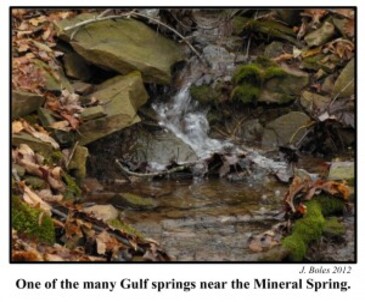
It took the research team from the Museum of disABILITY History, Jim Boles, Melissa Royer, Tracy Harrienger, and Will Philipps several months to find the spring and the remains of the well house and stone bottling basin. It was finally discovered on a stormy day in November 2012. However, there are many unanswered questions about the spring. There is written evidence that the spring was used for commercial bottling as early as 1861 and there is information that it was being revived as a commercial operation in 1906 although it is difficult to determine the layout of the bottling operation as it likely changed in the 50 years between 1861 - 1911. This is what we found:
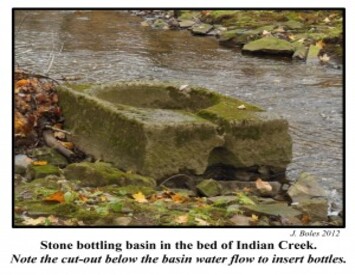
As described in the 1965 newspaper account, there is a 1911 date on the top of the basin. The stone bottling basin is a short distance from the spring house. Our present thought is that the bottling basin may have been higher off the ground on a log or stone-work platform and it was washed downstream and downhill from the spring house in a flood.
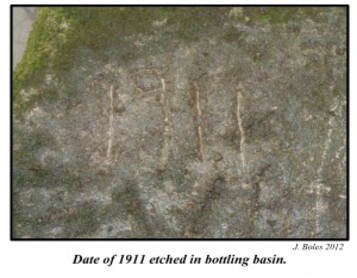
Further up the creek we found what is believed to be the foundation of the old spring house with what looks like a spring bubbling up within the structure. This is some distance from the bottling basin. How did the basin move? The spring presently has a strong sulphur odor. Early analysis of the Lockport Mineral Water by chemist George Hadley indicated that included in the composition of the water was sulphuretted hydrogen and a number of salts. Further plans are to have the spring water analyzed to compare with the 1861 report.
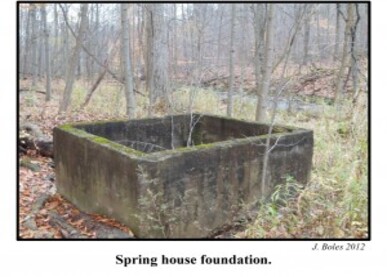
One last mystery between the bottling basin and the spring house foundation is a stone mound with a stone and cement frame in the center.
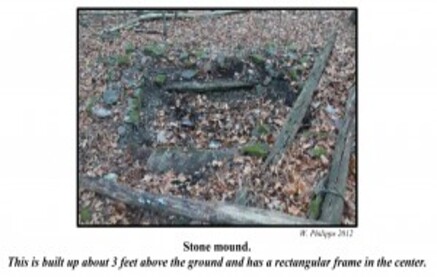
The mineral spring was in operation for a number of years and this may be an earlier foundation for a bottling basin.
The Museum of disABILITY History has been researching medicinal (healing) springs in the County for the past several years and would like to hear from readers that know of mineral, salt, or clear water springs in Niagara County as the material will eventually be included in a book that we are working on about the healing sanitariums, waters, food and tonics of Niagara County, NY.
- Category
- Museum of disABILITY History Blog
- Tags
- Mineral Springs | Natural Medicine | Niagara County | Research | Sanitariums | Tonics | Water Springs

Comments
Add a comment
BARBARA JOHNSON
Posted February 7, 2019 at 12:00 am